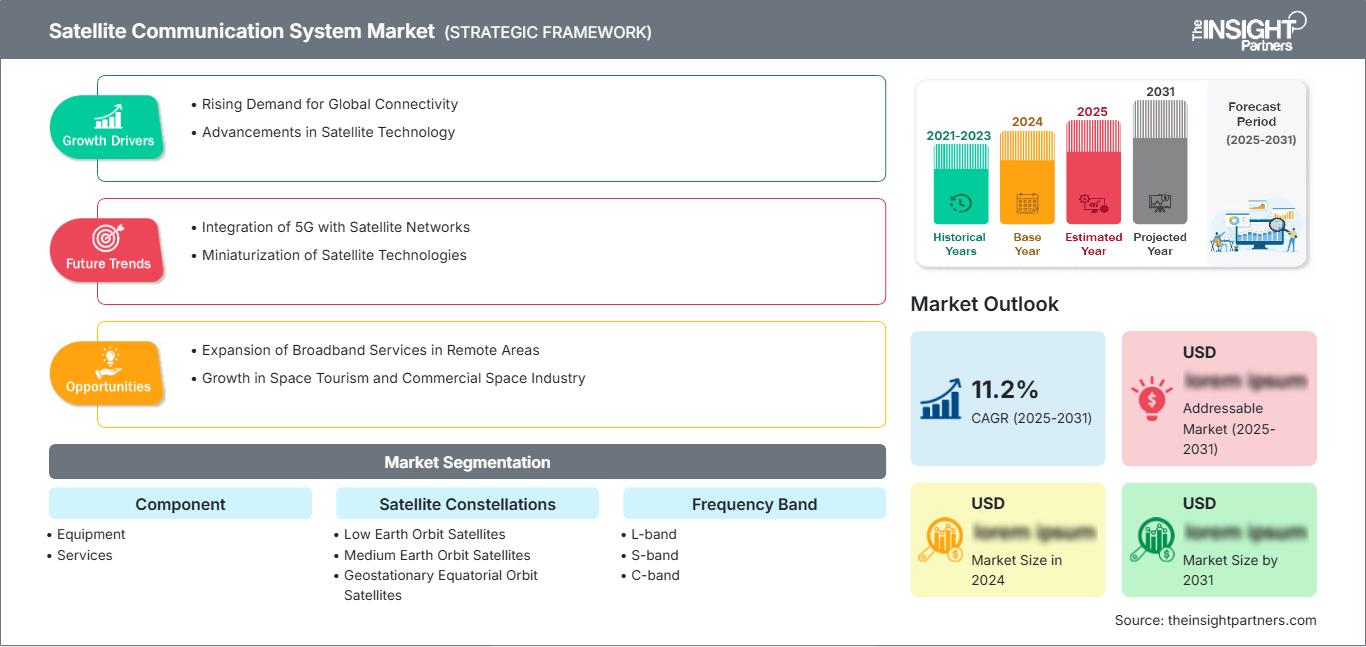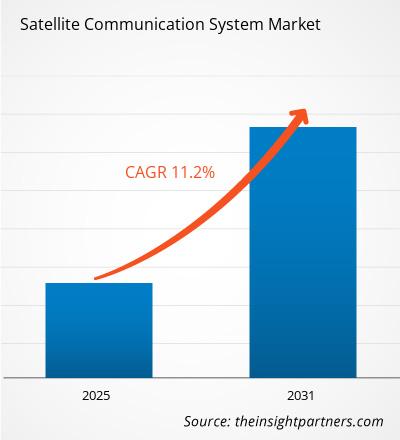Der Markt für Satellitenkommunikation wird voraussichtlich zwischen 2025 und 2031 eine durchschnittliche jährliche Wachstumsrate (CAGR) von 11,2 % verzeichnen, wobei die Marktgröße von XX Millionen US-Dollar im Jahr 2024 auf XX Millionen US-Dollar im Jahr 2031 anwachsen wird.
Der Bericht ist segmentiert nach Komponenten (Ausrüstung, Dienste), Satellitenkonstellationen [(Satelliten in erdnaher Umlaufbahn (LEO)), Satelliten in mittlerer Erdumlaufbahn (MEO) und geostationären äquatorialen Umlaufbahnen (GEO)], Frequenzbändern (L-Band, S-Band, C-Band, X-Band, Ku-Band, Ka-Band), vertikalen Bereichen (Energie und Versorgung, Transport und Fracht, Bergbau und Öl und Gas, Landwirtschaft, Sonstige). Die globale Analyse ist weiter auf regionaler Ebene und nach den wichtigsten Ländern aufgeschlüsselt. Der Bericht bietet den Wert in USD für die oben genannte Analyse und Segmente.
Zweck des Berichts
Der Bericht „Satellite Communication Market“ von The Insight Partners beschreibt die aktuelle Situation und das zukünftige Wachstum sowie die wichtigsten treibenden Faktoren, Herausforderungen und Chancen. Dadurch erhält er Einblicke für verschiedene Geschäftsinteressenten, wie z. B.:
- Technologieanbieter/-hersteller: Um die sich entwickelnde Marktdynamik zu verstehen und die potenziellen Wachstumschancen zu kennen, damit sie fundierte strategische Entscheidungen treffen können.
- Investoren: Um eine umfassende Trendanalyse hinsichtlich der Marktwachstumsrate, der finanziellen Marktprognosen und der Chancen entlang der Wertschöpfungskette durchzuführen.
- Regulierungsbehörden: Um Richtlinien und Überwachungsaktivitäten auf dem Markt zu regulieren, mit dem Ziel, Missbrauch zu minimieren, das Vertrauen der Investoren zu bewahren und die Integrität und Stabilität des Marktes aufrechtzuerhalten.
Marktsegmentierungskomponente für Satellitenkommunikation
- Ausrüstung
- Dienstleistungen
Satellitenkonstellationen
- Satelliten in erdnaher Umlaufbahn
- Satelliten in mittlerer Erdumlaufbahn
- Geostationäre Satelliten in äquatorialer Umlaufbahn
Frequenzband
- L-Band
- S-Band
- C-Band
- X-Band
- Ku-Band
- Ka-Band
Vertikal
- Energie und Versorgung
- Transport und Fracht
- Bergbau und Öl und Gas
- Landwirtschaft
Sie erhalten kostenlos Anpassungen an jedem Bericht, einschließlich Teilen dieses Berichts oder einer Analyse auf Länderebene, eines Excel-Datenpakets sowie tolle Angebote und Rabatte für Start-ups und Universitäten.
Markt für Satellitenkommunikationssysteme: Strategische Einblicke

- Holen Sie sich die wichtigsten Markttrends aus diesem Bericht.Dieses KOSTENLOSE Beispiel umfasst Datenanalysen, die von Markttrends bis hin zu Schätzungen und Prognosen reichen.
Wachstumstreiber für den Markt für Satellitenkommunikation
- Steigende Nachfrage nach globaler Konnektivität: Die zunehmende Nachfrage nach zuverlässigem, schnellem Internet und Kommunikationsdiensten in abgelegenen und unterversorgten Gebieten treibt den Markt für Satellitenkommunikation an. Satellitentechnologie bietet globale Abdeckung, insbesondere in ländlichen oder schwer erreichbaren Gebieten, wo herkömmliche Infrastrukturen nicht realisierbar sind, und ist daher eine entscheidende Lösung für universelle Konnektivität.
- Fortschritte in der Satellitentechnologie: Technologische Fortschritte wie die Entwicklung von Satelliten in erdnahen Umlaufbahnen (LEO) und effizienteren Kommunikationssystemen beflügeln den Markt für Satellitenkommunikation. Diese Innovationen bieten höhere Geschwindigkeiten, geringere Latenzzeiten und mehr Kapazität, die für Anwendungen wie Breitbanddienste und globale Kommunikationsnetze entscheidend sind.
Zukünftige Trends im Markt für Satellitenkommunikation
- Integration von 5G in Satellitennetze: Die Integration von Satellitennetzen in die 5G-Technologie ist ein wachsender Trend. Diese Integration soll die globale Reichweite von 5G-Netzwerken erhöhen, nahtlose Konnektivität in abgelegenen Gebieten ermöglichen und Dienste wie IoT, autonome Fahrzeuge und Smart Cities verbessern, die zuverlässige Kommunikationslösungen mit geringer Latenz erfordern.
- Miniaturisierung von Satellitentechnologien: Die Miniaturisierung von Satellitenkomponenten verändert den Markt für Satellitenkommunikation, indem sie Kosten senkt und die Entwicklung kleinerer Satelliten (CubeSats) ermöglicht, die erschwinglicher und vielseitiger sind. Diese kleineren Satelliten ermöglichen neue kommerzielle und Forschungsanwendungen wie Erdbeobachtung, Fernerkundung und Breitband-Internetdienste.
Marktchancen für Satellitenkommunikation
- Ausbau von Breitbanddiensten in abgelegenen Gebieten: Für Anbieter von Satellitenkommunikation bietet sich eine erhebliche Chance, Breitband-Internetdienste in ländlichen und abgelegenen Gebieten auszubauen. Da die Nachfrage nach Internetverbindungen weltweit steigt, werden satellitengestützte Breitbandlösungen zunehmend in unterversorgten Regionen eingesetzt, um die digitale Kluft zu überbrücken und wirtschaftliches Wachstum zu ermöglichen.
- Wachstum im Weltraumtourismus und in der kommerziellen Raumfahrtindustrie: Der Aufstieg der Weltraumtourismusindustrie und erhöhte Investitionen in die kommerzielle Weltraumforschung bieten neue Wachstumschancen für Anbieter von Satellitenkommunikation. Diese Vorhaben erfordern robuste Satellitenkommunikationssysteme für die Navigation, den Echtzeit-Datenaustausch und die Gewährleistung eines reibungslosen Betriebs in der Weltraumforschung, was zu einer höheren Nachfrage nach Satellitendiensten führt.
Regionale Einblicke in den Markt für Satellitenkommunikationssysteme
Die Analysten von The Insight Partners haben die regionalen Trends und Faktoren, die den Markt für Satellitenkommunikationssysteme im Prognosezeitraum beeinflussen, ausführlich erläutert. In diesem Abschnitt werden auch die Marktsegmente und die geografische Lage von Satellitenkommunikationssystemen in Nordamerika, Europa, dem asiatisch-pazifischen Raum, dem Nahen Osten und Afrika sowie Süd- und Mittelamerika erörtert.
Umfang des Marktberichts über Satellitenkommunikationssysteme
| Berichtsattribut | Einzelheiten |
|---|---|
| Marktgröße in 2024 | US$ XX million |
| Marktgröße nach 2031 | US$ XX Million |
| Globale CAGR (2025 - 2031) | 11.2% |
| Historische Daten | 2021-2023 |
| Prognosezeitraum | 2025-2031 |
| Abgedeckte Segmente |
By Komponente
|
| Abgedeckte Regionen und Länder | Nordamerika
|
| Marktführer und wichtige Unternehmensprofile |
|
Dichte der Marktteilnehmer für Satellitenkommunikationssysteme: Auswirkungen auf die Geschäftsdynamik verstehen
Der Markt für Satellitenkommunikationssysteme wächst rasant. Die steigende Nachfrage der Endnutzer ist auf Faktoren wie veränderte Verbraucherpräferenzen, technologische Fortschritte und ein stärkeres Bewusstsein für die Produktvorteile zurückzuführen. Mit der steigenden Nachfrage erweitern Unternehmen ihr Angebot, entwickeln Innovationen, um den Bedürfnissen der Verbraucher gerecht zu werden, und nutzen neue Trends, was das Marktwachstum weiter ankurbelt.

- Holen Sie sich die Markt für Satellitenkommunikationssysteme Übersicht der wichtigsten Akteure
Wichtige Verkaufsargumente
- Umfassende Abdeckung: Der Bericht analysiert umfassend Produkte, Dienstleistungen, Typen und Endnutzer des Satellitenkommunikationsmarktes und bietet einen ganzheitlichen Überblick.
- Expertenanalyse: Der Bericht basiert auf dem umfassenden Verständnis von Branchenexperten und Analysten.
- Aktuelle Informationen: Der Bericht gewährleistet Geschäftsrelevanz durch die Berichterstattung über aktuelle Informationen und Datentrends.
- Anpassungsoptionen: Dieser Bericht kann an spezifische Kundenanforderungen angepasst werden und passt sich so optimal an die Geschäftsstrategien an.
Der Forschungsbericht zum Satellitenkommunikationsmarkt kann daher dabei helfen, die Branchensituation und die Wachstumsaussichten zu entschlüsseln und zu verstehen. Obwohl es einige berechtigte Bedenken geben mag, überwiegen die Vorteile dieses Berichts tendenziell die Nachteile.
- Historische Analyse (2 Jahre), Basisjahr, Prognose (7 Jahre) mit CAGR
- PEST- und SWOT-Analyse
- Marktgröße Wert/Volumen – Global, Regional, Land
- Branchen- und Wettbewerbslandschaft
- Excel-Datensatz
Aktuelle Berichte
Erfahrungsberichte
Grund zum Kauf
- Fundierte Entscheidungsfindung
- Marktdynamik verstehen
- Wettbewerbsanalyse
- Kundeneinblicke
- Marktprognosen
- Risikominimierung
- Strategische Planung
- Investitionsbegründung
- Identifizierung neuer Märkte
- Verbesserung von Marketingstrategien
- Steigerung der Betriebseffizienz
- Anpassung an regulatorische Trends




















 Kostenlose Probe anfordern für - Markt für Satellitenkommunikationssysteme
Kostenlose Probe anfordern für - Markt für Satellitenkommunikationssysteme